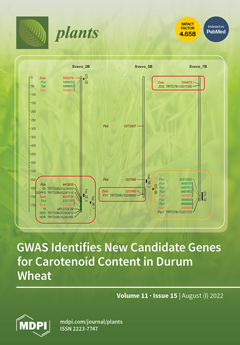Rhizoctonia root rot is one of the most destructive diseases of tomato and other crops. The biocontrol of plant diseases using endophytic bacteria has gained significant attention due to their distinct advantages compared with the free-living ones, as well as their new unexplored and unique properties. Endophytic
Bacillus subtilis SR22 represents a promising and more effective biocontrol and growth-promoting agent for tomato plants than the free-living agents, being an ecofriendly and sustainable tool in modern agriculture. In this study, the direct antagonistic activity of
B. subtilis SR22 was investigated against
Rhizoctonia solani in vitro. The biocontrol activity of
B. subtilis SR22 against Rhizoctonia root rot of tomato was also investigated. Effects on the level of the transcriptional expression of defense-related genes, biochemical responses, and the vegetative growth of tomato plants were also studied. The dual culture test showed 51% inhibition in the mycelial growth of
R. solani due to
B. subtilis SR22, indicating its potent antagonistic behavior. Using a GC-MS analysis, twenty bioactive compounds were detected to be produced by
B. subtilis SR22, including chlorogenic acid, pyrrolo [1,2-a]pyrazine-1,4-dione, hexahydro, propyl thioglycolic acid, phthalic acid, and 2,3-butanediol. Under greenhouse conditions, the application of
B. subtilis SR22 led to a reduction (up to 51%) in Rhizoctonia root rot of tomato. Furthermore, an upregulation in the expression of the responsive factor
JERF3 (10.9-fold) and the defense-related genes
POD (9.1-fold) and
PR1 (4.5-fold) in tomato plants was recorded due to the application of
B. subtilis SR22. In addition, this treatment enhanced the total phenolic content (76.8%) and activity of the antioxidant enzymes POD (56%) and PPO (29.2%) in tomato roots, indicating its resistance-inducing effect on tomato plants. Moreover, this treatment enhanced most of the evaluated growth parameters in tomato plants (up to 35%). We can conclude that
B. subtilis SR22 is a promising biocontrol agent and growth promoter in tomato plants against Rhizoctonia root rot. An evaluation of the formulation and field application of this bio-agent is necessary in future studies.
Full article






